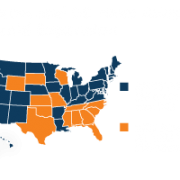You are looking at an archived version of our site. Please visit thepcc.org for a fresh, new experience!
Medicaid/SCHIP
Medicaid Parity
The Medicaid Pay Parity program was a provision outlined within the Affordable Care Act that increased Medicaid provider reimbursement to match that of Medicare providers. This provision expired on December 31, 2014 and was not extended nationally. However, some states are choosing to continue Medicaid pay parity.
7 States chose to extend Medicaid pay parity: Alabama, Colorado, Iowa, Maryland, Mississippi, and New Mexico. In addition, Alaska is paying doctors even more than the Medicare rate.
8 states chose to increase Medicaid reimbursement, but not to the full Medicare rate: Connecticut, Delaware, Hawaii, Maine, Michigan, Nebraska, Nevada, and South Carolina
In addition to these state legislative action, federal legislative action was taken in the form of the Medicaid Parity Act of 2015 (H.R.1502). This bill was introduced by Representative John Lewis on March 19, 2015 and was referred to the Subcommittee on Health on March 20, 2015. This bill seeks to amend title XIX (Medicaid) of the Social Security Act to extend through 2019.
Another bill, the Ensuring Access to Primary Care for Women and Children Act, (H.R.2253), was introduced by Representative Kathy Castor in the House of Representatives on May 12, 2015. It was referred to the Subcommittee on Health on May 15, 2015. This bill seeks to amend title XIX of the Social Security Act to extend the application of the Medicare payment rate floor to primary care services furnished under Medicaid and to apply the rate floor to additional providers of primary care services.
Resources
Population Health Management | September 2013

National Academy for State Health Policy | September 2013
Access Report | August 2013

Health Affairs | August 2013

National Academy for State Health Policy | July 2013

Patient-Centered Primary Care Collaborative | June 2013
- ‹ précédent
- 8 of 10
- suivant ›
News
February 20, 2019 | Kaiser Family Foundation
January 31, 2019 | Health Affairs Blog
January 29, 2019 | FierceHealthPayer
- ‹ précédent
- 8 of 31
- suivant ›
Events & Media
September 16, 2013 | National Council for Behavioral Health
April 24, 2014 | PCPCC
October 8, 2013 | Care Team Connect
- ‹ précédent
- 8 of 11
- suivant ›
Related Content
| Titolo | Date | Source | |
|---|---|---|---|
|
|
Oral Health Integration in the Patient-Centered Medical Home (PCMH) Environment | September 2012 | Qualis Health |
 |
Colorado’s Patient-Centered Medical Home Pilot Met Numerous Obstacles, Yet Saw Results Such As Reduced Hospital Admissions | September 2012 | Health Affairs |
|
|
Patient-Centered Medical Homes Improve Access and Quality of Care | August 2011 | Amerigroup |
|
|
Strategies States Can Use to Support the Infrastructure of a Medical Home | May 2008 | National Academy for State Health Policy |
Pagine
Pagine
Associated Stakeholders:
Secondary menu
Copyright © 2024 Primary Care Collaborative









